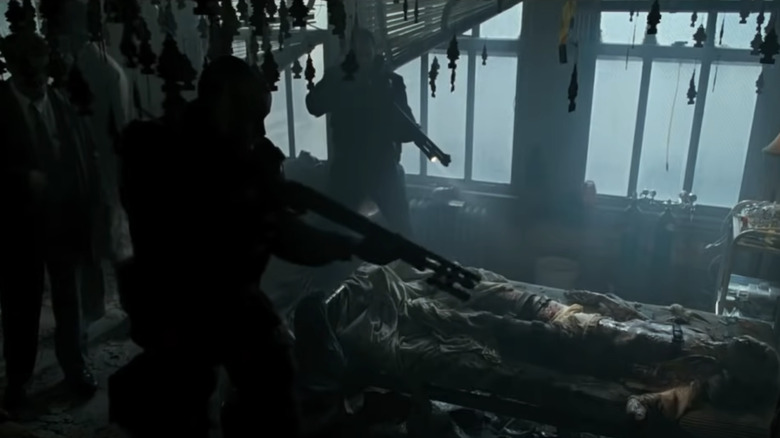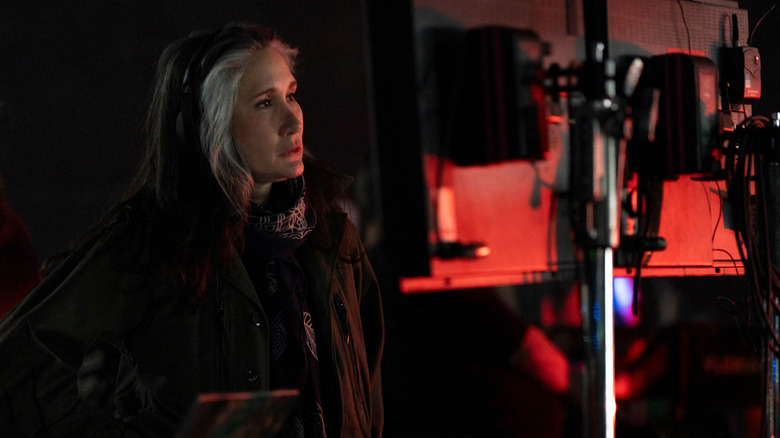True Detective: Night Country Just Recalled David Fincher's Most Disturbing Moment
This article contains spoilers for "True Detective: Night Country" episode 2.
After three seasons, show creator Nic Pizzolatto has stepped away from "True Detective," clearing the way for new showrunner Issa López. The writer/director of 2017's excellent "Tigers Are Not Afraid" has created what might be the best season of "True Detective" since the original, restoring cosmic horror elements to the show and bringing back plenty of the dense philosophizing that Matthew McConaughey's Rust Cohle provided in season 1.
It seems that the inaugural season was a big influence on López, who has spoken about trying to emulate the tone of Pizzolatto's Louisiana noir. However, the new showrunner also found that her rewatch of season 1 led her to another influence: David Fincher's 1995 film "Seven." As she told the "Movies That Made Me" podcast, "What immediately hit me is how similar ['True Detective' season 1] is to 'Seven,'" before going on to reveal that her rewatch of "True Detective" led her to revisit Fincher's crime thriller, explaining how it informed her creative process for "Night Country":
"The atmosphere and, 'We're living in this world that is broken and corrupt and there's nothing we can do because it will eat us' is what 'True Detective' is, absolutely. And this feeling of something very corrupt happening behind the scenes of the parts of society we don't want to look at, which are all of the things that helped me for 'Night Country'."
But as the opening of episode 2 of "Night Country" reveals, it wasn't just a general atmosphere or point of view that López took from "Seven."
The sloth victim in Seven
"Seven" is, as López put it, "masterful." It epitomizes a certain type of crime thriller that has been consistently emulated since its 1995 release. But Fincher and writer Andrew Kevin Walker's usage of the audience's imagination against them is what has always stuck with me. Throughout the film, we're shown plenty of gruesome crime scenes but we never actually witness any of the seven deadly sins murders take place. Even the film's infamous ending refrains from showing us exactly what's in the box — because our imaginations are capable of dreaming up worse horrors than Fincher could ever depict.
But every now and then, even the director isn't above terrifying the absolute pants off us all with a good old jump scare, and "Seven" contains one of the best and most disturbing examples. Mid-way through the film, Morgan Freeman and Brad Pitt's detective duo discover the "sloth" crime scene, featuring a victim played by Michael Reid McKay who's shackled to a bed and has seemingly been starved to death. But just as we're coming to terms with the grim image of his emaciated body, that body comes to life, writhing and screaming in what is one of the most hauntingly terrifying scenes in crime thriller history.
Aside from the "sloth" victim makeup being torturous enough in and of itself, the moment when the body awakens might be the most upsetting thing in the whole of "Seven" — aside from the ending, that is. Oh, and that bladed sex "toy." Come to think of it, "Seven" is pretty upsetting throughout. But it seems the "sloth" victim was what stood out to López, who created her very own version of the scene in the opening of "Night Country" episode 2.
Night Country borrows directly from the sloth victim scene
After a brilliant opening episode that set a deliciously bleak and apocalyptic tone, the second installment of "True Detective: Night Country" starts with a similarly upsetting scene that should give everyone a nice jolt. Having discovered the bodies of the missing Tsalal research station workers sunken into the Alaskan tundra at the end of the last episode, Jodie Foster's Liz Danvers and her officers behold the gruesome "corpsicle" and begin chipping away at the scene to remove the bodies.
But as the crew works, one of the bodies suddenly awakens with an agonizing scream, causing everyone, including the typically stoic Danvers, to recoil in horror. Had López not cited "Seven" as being so fundamentally influential, it would be harder to say whether this was a Fincher-inspired moment. But considering López specifically spoke about Fincher's film as being so significant in her prep work, I think it's safe to say that the conscious body in the ice is the showrunner's homage to the sloth victim of "Seven" — a scene that remains one of the scariest of all time.
It might seem a little unrealistic to have a frozen body that's been sitting in Arctic ice for some time suddenly come to life, but is it really any more unbelievable than what looks like a literal decomposed corpse coming to life in "Seven?" If anything, when considered alongside the otherwise tasteful and creeping sense of dread that Lopez has managed to establish, it shows that the showrunner has a well-rounded appreciation for Fincher's willingness to punctuate slow-building terror with startling moments of pure horror. We'll have to keep an eye out for whatever else López borrows from the maestro as the season continues.
New episodes of "True Detective: NIght Country" drop Sundays on HBO and Max.


